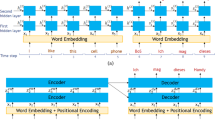Abstract
We develop in this paper a theoretical framework for the topological study of time series data. Broadly speaking, we describe geometrical and topological properties of sliding window embeddings, as seen through the lens of persistent homology. In particular, we show that maximum persistence at the point-cloud level can be used to quantify periodicity at the signal level, prove structural and convergence theorems for the resulting persistence diagrams, and derive estimates for their dependency on window size and embedding dimension. We apply this methodology to quantifying periodicity in synthetic data sets and compare the results with those obtained using state-of-the-art methods in gene expression analysis. We call this new method SW1PerS, which stands for Sliding Windows and 1-Dimensional Persistence Scoring.







Similar content being viewed by others
References
A. Adcock, E. Carlsson and G. Carlsson, The Ring of Algebraic Functions on Persistence Bar Codes, Preprint http://comptop.stanford.edu/u/preprints/multitwo, 2012
A. J. Blumberg, I. Gal, M. A. Mandell and M. Pancia, Persistent homology for metric measure spaces, and robust statistics for hypothesis testing and confidence intervals, arXiv preprint http://arxiv.org/pdf/1206.4581, 2012
G. Carlsson, Topology and Data, Bulletin of the American Mathematical Society, vol 46(2), pp. 255–308, 2009.
G. Carlsson, T. Ishkhanov, V. de Silva and A. Zomorodian, On the local behavior of spaces of natural images, International Journal of Computer Vision, vol 7(1), pp. 1–12, 2008.
F. Chazal, D. Cohen-Steiner, M. Glisse, L. J. Guibas, and S. Y. Oudot, Proximity of persistence modules and their diagrams, In SCG, pp. 237–246, 2009.
D. Cohen-Steiner, H. Edelsbrunner and J. Harer, Stability of persistence diagrams, Discrete and Computational Geometry, vol 37(1), pp. 103–120, 2007.
D. Cohen-Steiner, H. Edelsbrunner, J. Harer and Y. Mileyko, Lipschitz Functions Have \(L^p\)-Stable Persistence, Foundations of Computational Mathematics, vol 10(2), pp. 127–139, 2010.
D. Comaniciu and P. Meer, Mean shift: A robust approach toward feature space analysis, Pattern Analysis and Machine Intelligence, vol 24(5), pp. 603–619, 2002.
V. de Silva, D. Morozov and M. Vejdemo-Johansson, Persistent Cohomology and Circular Coordinates, Discrete & Computational Geometry, vol 45(4), pp. 737–759, 2011.
V. de Silva, P. Skraba and M. Vejdemo-Johansson, Topological Analysis of Recurrent Systems, Workshop on Algebraic Topology and Machine Learning, NIPS 2012, Preprint available at url: http://sites.google.com/site/nips2012topology/contributed-talks
A. Deckard, R. Analfi, D. Orlando, J. Hogenesch, S. Haase and J. Harer, Design and Analysis of Large-Scale Biological Rhythm Studies: A Comparison of Algorithms for Detecting Periodic Signals in Biological Data, Bioinformatics, btt541v1-btt541, 2013.
H. Edelsbrunner and J. Harer Computational Topology, an Introduction, American Mathematical Society, (2010) (241 pages).
E. F. Glynn, J. Chen and A. Mushegian, Detecting periodic patterns in unevenly spaced gene expression time series using Lomb-Scargle periodograms, Bioinformatics, vol 22(3), pp. 310–316, 2006.
A. Hatcher Algebraic Topology. Cambridge Univ. Press, England, 2002.
M. E. Hughes, J. B. Hogenesch and K. Kornacker, JTK-CYCLE: An Efficient Nonparametric Algorithm for Detecting Rhythmic Components in Genome-Scale Data Sets, Journal of Biological Rhythms, vol 25(372), pp. 372–380, 2010.
H. Kantz and T. Schreiber, Nonlinear Time Series Analysis, Cambridge University Press, 2003.
H. S. Kim, R. Eykholt and J. D. Salas, Nonlinear dynaimcs, delay times, and embedding windows, Physica D: Nonlinear Phenomena, vol 127(1), pp. 48–60, 1999.
N. R. Lomb, Least-squares frequency analysis of unequally spaced data, Astrophysics and Space Science, vol 39, pp. 447–462, 1976.
Y. Mileyko, S. Mukherjee, and J. Harer, Probability measures on the space of persistence diagrams, Inverse Problems, 27(12), p.p. 124007, 2011.
K. Mischaikow and V. Nanda, Morse Theory for Filtrations and Efficient Computation of Persistent Homology, To appear on Discrete and Computational Geometry, 2013.
J. R. Munkres Elements of Algebraic Topology. Addison-Wesley, Redwood City, California, 1984.
M. A. Pinsky, Introduction to Fourier Anlysis and Wavelets, The Brooks/Cole Series in Advanced Mathematics, USA, 2003.
J. A. Perea, A. Deckard, S. B. Haase and J. Harer, SW1PerS: Sliding Windows and 1-Persistence Scoring; Discovering Periodicity in Gene Expression Time Series Data, preprint (2013).
J. D. Scargle, Studies in astronomical time series analysis. II-Statistical aspects of spectral analysis of unevenly spaced data, Astrophysical Journal, vol 263, pp. 835–853, 1982.
C. J. Stam, Nonlinear dynamical analysis of EEG and MEG: Review of an emerging field, Clinical Neurophisiology, 116, pp. 2266–2301, 2005.
N. Hundewale, The application of methods of nonlinear dynamics for ECG in Normal Sinus Rythm, Int. J. of Computer Science, 9, pp. 458–467, 2012.
C. E. Shannon, Communication in the presence of noise, Proc. Inst. Radio Eng., vol. 37, no. 1, pp. 10–21, 1949.
F. Takens, Detecting strange attractors in turbulence. in D. A. Rand and L. -S. Young. Dynamical Systems and Turbulence, Lecture Notes in Mathematics, vol. 898. Springer-Verlag. pp. 366–381.
A. Tausz, M. Vejdemo-Johansson and H. Adams, JavaPlex: A research software package for persistent (co)homology, 2011, Software available at url: http://code.google.com/p/javaplex
A. Zomorodian and G. Carlsson, Computing Persistent Homology, Discrete & Computational Geometry, vol 33(2), pp. 249–274, 2005.
Acknowledgments
Both authors were supported in part by DARPA under Grants D12AP00001 and D12AP00025-002 and by the AFOSR under Grant FA9550-10-1-0436.
Author information
Authors and Affiliations
Corresponding author
Additional information
Communicated by Herbert Hedelsbrunner.
Rights and permissions
About this article
Cite this article
Perea, J.A., Harer, J. Sliding Windows and Persistence: An Application of Topological Methods to Signal Analysis. Found Comput Math 15, 799–838 (2015). https://doi.org/10.1007/s10208-014-9206-z
Received:
Revised:
Accepted:
Published:
Issue Date:
DOI: https://doi.org/10.1007/s10208-014-9206-z




